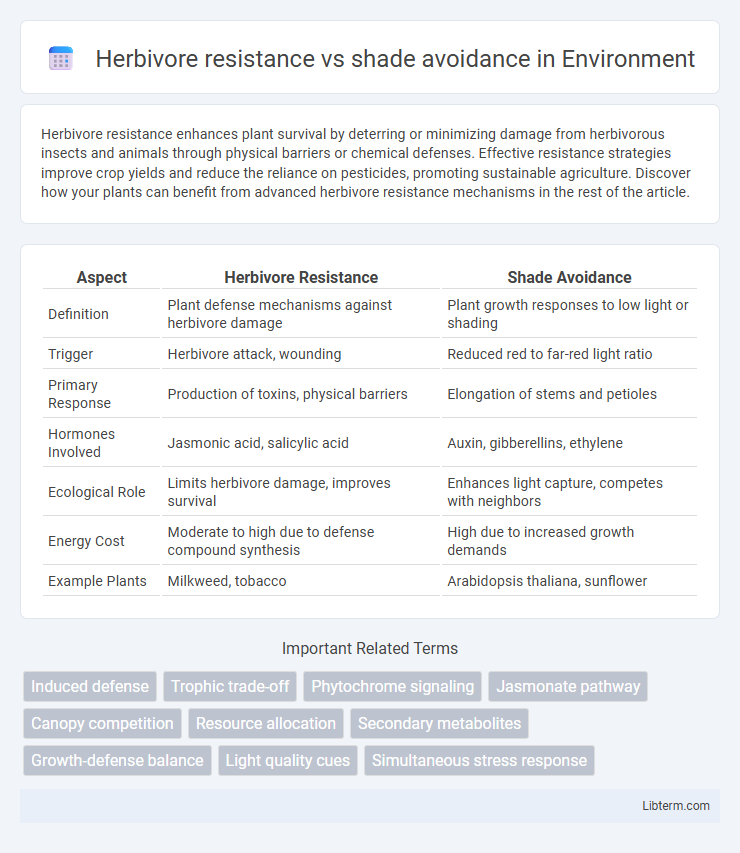Herbivore resistance enhances plant survival by deterring or minimizing damage from herbivorous insects and animals through physical barriers or chemical defenses. Effective resistance strategies improve crop yields and reduce the reliance on pesticides, promoting sustainable agriculture. Discover how your plants can benefit from advanced herbivore resistance mechanisms in the rest of the article.
Table of Comparison
| Aspect | Herbivore Resistance | Shade Avoidance |
|---|---|---|
| Definition | Plant defense mechanisms against herbivore damage | Plant growth responses to low light or shading |
| Trigger | Herbivore attack, wounding | Reduced red to far-red light ratio |
| Primary Response | Production of toxins, physical barriers | Elongation of stems and petioles |
| Hormones Involved | Jasmonic acid, salicylic acid | Auxin, gibberellins, ethylene |
| Ecological Role | Limits herbivore damage, improves survival | Enhances light capture, competes with neighbors |
| Energy Cost | Moderate to high due to defense compound synthesis | High due to increased growth demands |
| Example Plants | Milkweed, tobacco | Arabidopsis thaliana, sunflower |
Introduction to Plant Stress Responses
Plants respond to herbivore resistance and shade avoidance through distinct but interconnected stress response pathways that optimize survival under biotic and abiotic pressures. Herbivore resistance involves activating defense mechanisms such as the production of secondary metabolites, while shade avoidance triggers growth adjustments like stem elongation mediated by phytochrome signaling. Understanding these responses provides insight into how plants balance resource allocation between defense and growth to adapt effectively to environmental challenges.
Defining Herbivore Resistance in Plants
Herbivore resistance in plants refers to the ability to deter or withstand damage caused by herbivorous insects or animals through physical traits such as thorns, tough leaves, or chemical defenses like alkaloids and tannins. This adaptive mechanism minimizes tissue loss and preserves photosynthetic efficiency under herbivory pressure. Plants balance herbivore resistance with shade avoidance, where energy allocation shifts between defense production and growth responses to low light conditions.
Understanding Shade Avoidance Mechanisms
Shade avoidance in plants involves elongated growth and altered leaf orientation to optimize light capture under canopy shade, triggered by changes in red to far-red light ratio detected by phytochrome photoreceptors. This adaptive response prioritizes vertical growth at the expense of other functions, such as defense, thus potentially increasing susceptibility to herbivores. Molecular signaling pathways involving auxin and gibberellins coordinate shade avoidance, highlighting a strategic trade-off between growth and herbivore resistance mechanisms in plant survival.
Evolutionary Trade-offs: Resistance vs. Avoidance
Herbivore resistance and shade avoidance represent evolutionary trade-offs shaping plant survival strategies, where investment in chemical and structural defenses against herbivores often limits resources available for growth adaptations to light competition. Genetic and physiological constraints force plants to balance between producing secondary metabolites that deter herbivory and elongating stems or adjusting leaf orientation to maximize photosynthesis under canopy shade. This trade-off influences species distribution, fitness, and adaptive evolution in diverse ecosystems, highlighting the complex interplay between biotic stress and abiotic resource acquisition.
Hormonal Signaling Pathways in Plant Defense
Herbivore resistance and shade avoidance in plants involve complex hormonal signaling pathways that balance growth and defense mechanisms. Jasmonic acid (JA) signaling predominantly triggers herbivore resistance by activating defense genes and producing secondary metabolites, while shade avoidance is regulated mainly by auxin and gibberellin pathways promoting elongation growth to compete for light. Crosstalk between these hormonal pathways modulates resource allocation, often suppressing JA-mediated defense during shade conditions to prioritize elongation and survival.
Genetic Regulation of Stress Adaptations
Herbivore resistance and shade avoidance represent distinct stress adaptation strategies regulated by complex genetic pathways in plants. Key genes such as JAZ repressors modulate jasmonate signaling for herbivore defense, while phytochrome-interacting factors (PIFs) control shade avoidance responses by adjusting plant architecture under low light. Cross-talk between these pathways involves transcription factors like MYC2 integrating environmental cues to balance growth and defense.
Resource Allocation: Growth or Defense?
Herbivore resistance and shade avoidance represent contrasting strategies in plant resource allocation, where energy is diverted either towards defense mechanisms or growth promotion. Plants facing herbivory invest in chemical and structural defenses, such as secondary metabolites and leaf toughness, to deter herbivores, often at the expense of rapid growth. In shaded environments, plants prioritize elongation and resource capture--enhancing stem height and leaf area--to outcompete neighbors for light, which can reduce resources allocated to defense, highlighting a trade-off between growth and protection.
Ecological Implications of Adaptation Strategies
Herbivore resistance and shade avoidance represent distinct plant adaptation strategies influencing ecosystem dynamics and species interactions. Herbivore resistance mechanisms reduce plant damage, promoting survival in highly infested environments while potentially limiting growth due to resource allocation toward defense compounds. Shade avoidance enhances light capture in densely populated habitats, but may compromise defense capabilities, affecting herbivore populations and plant community structure.
Case Studies: Species-Specific Responses
Herbivore resistance and shade avoidance strategies exhibit species-specific responses that reflect distinct ecological adaptations. In Arabidopsis thaliana, herbivore attack triggers jasmonate-mediated defense pathways, reducing susceptibility to insect herbivores, while shade conditions suppress these pathways to prioritize growth. Conversely, maize utilizes a balance between auxin-driven shade avoidance and induced volatile organic compounds to deter herbivores, demonstrating divergent signaling integration across species.
Future Directions in Plant Adaptive Research
Future directions in plant adaptive research will prioritize elucidating the molecular crosstalk between herbivore resistance pathways and shade avoidance syndrome to optimize plant fitness under simultaneous biotic and abiotic stress. Advances in genomic editing tools like CRISPR/Cas9 will facilitate targeted manipulation of key genes such as JA (jasmonic acid) receptors and PHY (phytochrome) photoreceptors, enabling precise modulation of defense and growth trade-offs. Integration of multi-omics data and phenotypic plasticity models will enhance the prediction of plant adaptive responses, informing crop improvement strategies for sustainable agriculture.
Herbivore resistance Infographic

 libterm.com
libterm.com